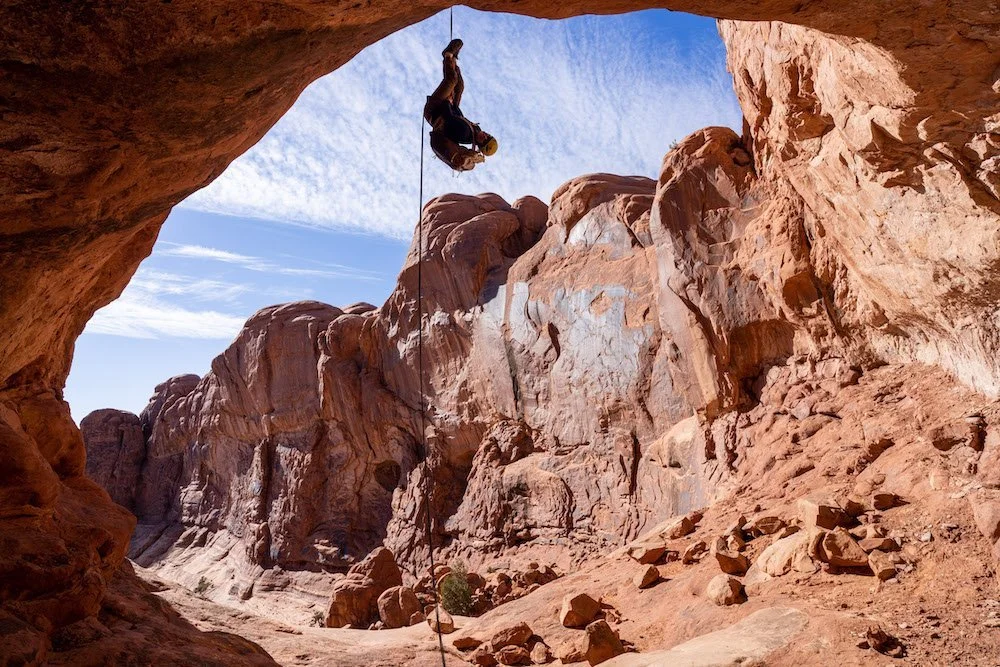12 Pro Tips for Beginner Canyoneers
Canyoneering is an exhilarating outdoor adventure that combines hiking, climbing, rappelling, and swimming through rugged canyons. It offers a thrilling way to explore some of the most beautiful and remote landscapes, where every twist and turn reveals new challenges and stunning scenery. For those new to canyoneering, this sport can seem daunting, but with the right knowledge and preparation, you can embark on your first canyoneering adventure with confidence. These 12 pro tips are designed to help beginners get started, ensuring a safe and unforgettable experience as you navigate your way through the canyons.
Pretending to be Spiderman while rappelling in Arches National Park. Photo by Dalton Johnson
Background:
Canyoneering has its roots in exploration and adventure, with early pioneers seeking to discover hidden canyons and untamed wilderness. Over time, it has evolved into a popular outdoor activity, attracting thrill-seekers and nature lovers alike. Canyoneering often involves a combination of technical skills such as rappelling down waterfalls, scrambling over rocks, and wading through pools, making it a dynamic and varied experience. While it can be physically demanding, canyoneering is also incredibly rewarding, offering unique access to some of the world's most spectacular natural wonders.
12 Pro Tips for Beginner Canyoneers:
1. Start with a Guided Trip
For your first canyoneering experience, consider joining a guided trip. Professional guides can teach you essential skills, provide safety instruction, and choose a canyon that matches your ability level. A guided trip is a great way to learn the basics and build confidence before attempting more advanced canyons on your own.
2. Learn the Basics of Rappelling
Rappelling is a key skill in canyoneering, as many routes involve descending steep cliffs or waterfalls. Take the time to practice rappelling in a controlled environment, such as a climbing gym or with an experienced instructor. Understanding proper technique, how to use a harness, and how to control your descent are crucial for your safety and enjoyment in the canyon.
3. Understand the Rating System
Canyons are rated based on their technical difficulty, exposure, and water levels. Familiarize yourself with the canyoneering rating system, which typically ranges from Class 1 (easiest) to Class 4 or 5 (most difficult). As a beginner, start with Class 1 or 2 canyons that involve easy hiking and minimal technical challenges. Gradually work your way up as you gain experience.
4. Check the Weather
Weather conditions can significantly impact your canyoneering experience, especially in slot canyons where flash floods can occur. Always check the weather forecast before your trip, paying close attention to rain patterns and potential storms. Avoid canyoneering during or after heavy rain, as flash floods can quickly turn a canyon into a dangerous environment.
5. Know How to Read Topographic Maps
Navigating through a canyon requires more than just following a trail. Learn how to read topographic maps and understand the landscape, including elevation changes, water sources, and potential exits. This skill is vital for planning your route and ensuring you stay on track, especially in remote areas where GPS signals may be unreliable.
6. Pack a Dry Bag for Essentials
Keeping your essentials dry is crucial in canyoneering, where you may encounter water crossings or swim through pools. Invest in a good-quality dry bag to store items like your phone, map, snacks, and any other gear you want to keep dry. A dry bag ensures that your belongings stay safe and functional throughout your adventure.
7. Use Proper Footwear
Canyoneering involves traversing a variety of terrain, from slippery rocks to sandy paths. Wear shoes that provide good traction, support, and protection, such as approach shoes or canyoneering boots. Avoid regular hiking boots or sneakers, which may not offer the grip needed for wet or rocky conditions. Proper footwear reduces the risk of slipping and ensures comfort during long days in the canyon.
8. Develop Teamwork Skills
Canyoneering is often done in groups, and teamwork is essential for a successful and safe experience. Learn how to communicate effectively with your group, assist others during technical sections, and work together to solve problems. Good teamwork not only enhances safety but also makes the adventure more enjoyable and rewarding.
9. Practice Efficient Movement
Efficiency is key when navigating through canyons, especially in technical sections. Practice moving quickly and smoothly over obstacles, such as boulders or narrow slots. This includes learning how to scramble, downclimb, and navigate tight spaces with minimal effort. Efficient movement helps you conserve energy and reduces the time spent in potentially hazardous areas.
10. Respect the Environment
Canyoneering takes you into some of the most pristine and fragile environments on Earth. It’s important to practice Leave No Trace principles, such as packing out all trash, staying on established routes, and avoiding the disturbance of natural features. Respecting the environment ensures that these beautiful places remain unspoiled for future adventurers.
11. Build Your Physical Fitness
Canyoneering can be physically demanding, requiring strength, endurance, and flexibility. Build your physical fitness through activities like hiking, climbing, and swimming to prepare your body for the challenges of the canyon. Focus on exercises that improve your core strength, balance, and cardiovascular endurance, which are all essential for navigating difficult terrain.
12. Embrace the Adventure
Canyoneering is as much about the experience as it is about the destination. Embrace the sense of adventure that comes with exploring hidden canyons, overcoming obstacles, and discovering new landscapes. Stay open to the unexpected, and enjoy the thrill of stepping outside your comfort zone. With the right mindset, canyoneering can be one of the most rewarding outdoor activities you’ll ever try.
The final overhanding rappel on a canyoneering route in Arches National Park. Photo by Dalton Johnson
Canyoneering offers an unparalleled adventure that combines the thrill of exploration with the beauty of the natural world. By following these 12 pro tips, you’ll be well-prepared to embark on your first canyoneering journey with confidence. Remember to prioritize safety, respect the environment, and savor every moment of the experience. With the right preparation and attitude, canyoneering can become a lifelong passion that takes you to some of the most breathtaking places on Earth.












